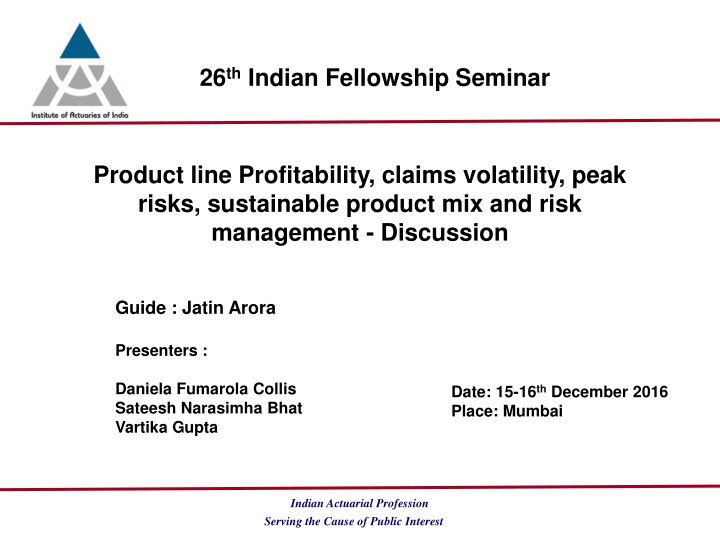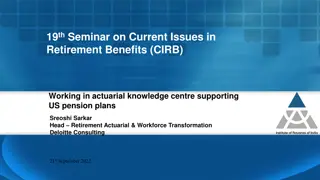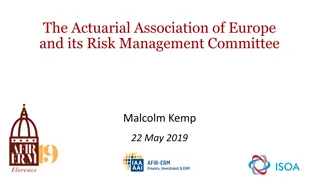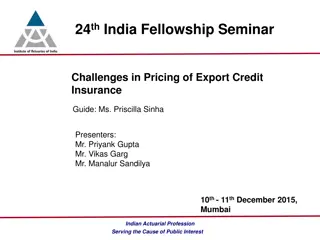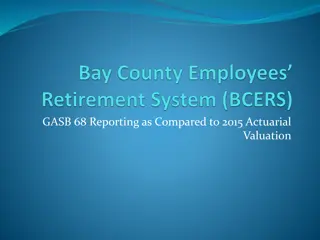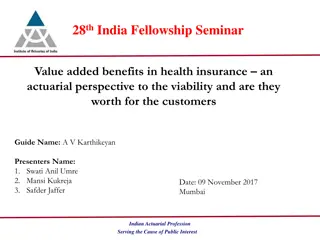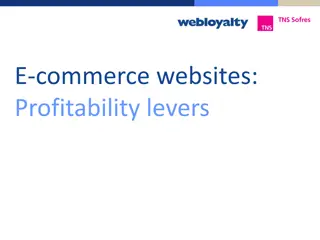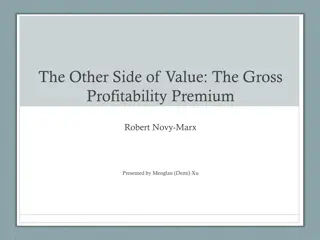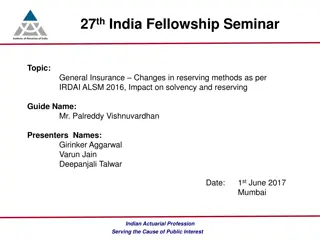Indian Actuarial Seminar on Product Line Profitability and Risk Management
Explore the discussions at the 26th Indian Fellowship Seminar focusing on product line profitability, claims volatility, peak risks, sustainable product mix, and risk management in the field of actuarial science. Learn about the importance of product line profitability, how it is quantitatively and qualitatively determined, and the key factors impacting profitability. Gain insights into tools and strategies for effective risk management and sustainable growth within multi-product portfolios.
Download Presentation

Please find below an Image/Link to download the presentation.
The content on the website is provided AS IS for your information and personal use only. It may not be sold, licensed, or shared on other websites without obtaining consent from the author.If you encounter any issues during the download, it is possible that the publisher has removed the file from their server.
You are allowed to download the files provided on this website for personal or commercial use, subject to the condition that they are used lawfully. All files are the property of their respective owners.
The content on the website is provided AS IS for your information and personal use only. It may not be sold, licensed, or shared on other websites without obtaining consent from the author.
E N D
Presentation Transcript
26th Indian Fellowship Seminar Product line Profitability, claims volatility, peak risks, sustainable product mix and risk management - Discussion Guide : Jatin Arora Presenters : Daniela Fumarola Collis Sateesh Narasimha Bhat Vartika Gupta Date: 15-16th December 2016 Place: Mumbai Indian Actuarial Profession Serving the Cause of Public Interest
26th Indian Fellowship Seminar Product line Profitability, claims volatility, peak risks, Sustainable product mix and risk management - Discussion Indian Actuarial Profession Serving the Cause of Public Interest
Product Line Profitability - Contents What it means and its importance How is it derived? Quantitatively - Economic and Regulatory aspect Qualitatively Practical challenges involved www.actuariesindia.org 3
What it means and its importance? Meaning Importance Product Line Profitability (PLP) is a diagnostic tool determine the true profitability of each product within multi-product portfolio. Pricing Adequacy that helps us Management decisions Growth areas Capital Allocation It provides an early warning signal that a product or a product line is at risk. Reinsurance Current and new Regulatory reporting Requirement for AA to conduct periodical product review It is not necessary that the products contributing highest to the top line of a company will contribute highest to the bottom line as well! Premium Deficiency Reserve www.actuariesindia.org 4
How it is determined quantitatively? ( Premiums Earned Claims incurred Expenses Incurred + Investment Income - Tax paid - Cost of capital (Capital * COC %age)) / Average capital over the year Risk Adjusted Profitability by product Premiums Earned Claims Incurred Expenses Incurred Investment Income Cost of Capital Determination of total required capital either using standard formula or internal model Gross Written Premium Gross Claims Paid Expenses Paid Investment income on insurance funds related to the product line e.g. reserves Commissions Paid Reinsurance Premiums RI and Other Recoveries Reinsurance Commissions Received Change in UPR Change in OSLR and IBNR Weighted average cost of capital if company uses both debt & equity Investment income on free reserves Allocated G&A Expenses www.actuariesindia.org 5
How it is determined? Qualitative factors Management future views about growth and profitability of the product lines. Accepting a low profit product to enter/grow/capture market Cross selling across product lines Marketing strategy and projected volumes needs to be realistic ( APS 7.1) Customer profile, confidence and attitude towards risk APS 2.2 states that any action taken needs to consider the policyholder s interest and appropriately monitored. Market cycles This will impact cost of debt/equity for different product lines. A longer tailed line with have reserves and capital tied up for long durations impacting profitability Existing competition in the industry Opportunity cost of capital Alternative uses of capital/cost of capital www.actuariesindia.org 6
Practical Challenges Subjectivity in underlying assumptions Long-tailed lines Estimation of Reserves Company specific vs Market averages Formulistic approach vs Internal models Time horizon differences One year vs ultimate view Economic vs Regulatory reporting Basis of allocating G&A expenses to different product lines Allocation of RI recoveries & reserves in case of global RI covers Allocation One off events May distort the profitability for a particular year. Large Losses / CAT events Inherent judgment involved in assumptions selection Interpretation and implementation of changed regulations - Changes in tariff rates/ Conflicts of interest stated in APS 4.1 Difference of opinions Lack of data availability and appropriate models Adequacy of premiums as stated in APS 6.1 Judgment in underlying assumptions Competence as defined in GN 3.2 New products www.actuariesindia.org 7
26th Indian Fellowship Seminar Product line Profitability, Claims volatility, peak risks, Sustainable product mix and risk management - Discussion Indian Actuarial Profession Serving the Cause of Public Interest
Claims volatility definition Claims volatility is driven by changes in frequency and severity trends impacting the ultimate cost of claims. Unanticipated increased in frequency and severity of claims can adversely impact the profitability and financial condition of insurance companies by increasing the claims ratio and reducing or eroding profit margins. Extreme volatility (e.g. natural catastrophe risks) can have a severe impact on overall solvency if left unmitigated. FREQUENCY MEASURES THE AMOUNT OF CLAIMS PER EXPOSURE UNIT SEVERITY IS THE AVERAGE LOSS PER CLAIM Motor claims frequency is directly linked to the number of miles driven Homeowners insurance is impacted by the overall state of the economy Reduction in the average age of cars on the roads drives up severity due to increase in repair cost Increase in average house size drives up claims costs for homeowner claims www.actuariesindia.org 9
Claims volatility peak risks Some lines of business are more subject to exceptional large losses peak or catastrophe risks. Catastrophes refer to adverse events whose occurrence results in a sudden and mass destruction of property, lives, environment, can depending on the severity can have a material impact on the country affected. Catastrophes can be caused by natural or man-made events. From an insurance perspective catastrophe risks are highest where significant potential for adverse events coincides with population and building density. Peak Risks pose significant challenges to actuaries as they can be difficult to price and reserve (e.g. use of equalization reserves), leading to potential unquantified exposures that can impact both profitability and capital. www.actuariesindia.org 10
Claims volatility key drivers There are many reasons leading to an increase in claims volatility: 1. Inflation is a key driver of severity for both property and bodily injury claims. Increase in the cost of auto parts and auto repair, increase in medical costs Changes in the underlying business mix, e.g. a shift from older to younger drivers 2. Changes in the judicial system. Increases in court awards, change in retroactive liability 3. Advances in medical science linking diseases to environmental exposures 4. Changes in the economic environment, e.g. increase in unemployment leading to rise in fraudulent claims 5. Increase in natural disasters due to global warming leading to higher frequency of natural catastrophes These elements are difficult to predict and quantify as generally they are not included in the historical data. www.actuariesindia.org 11
Claims volatility the role of the actuary ACTUARIAL PRACTICE STANDARD APS (21) APPOINTED ACTUARY AND GENERAL INSURANCE BUSINESS PROFESSIONAL CHALLENGES Actuaries have an ethical/professional duty to address all aspects related to the profitability/solvency of an insurance company and to select appropriate assumptions for pricing and reserving despite the pressure from management 5.4 The Appointed Actuary must have regard to all aspects likely to affect the financial condition of the company, including but not limited to the following; 5.4.4 The current and likely future claims experience including claims handling expenses; 6.3 Premium Rate Components - The Appointed Actuary should also analyse the insurer s own claims experience and, where possible, compare it with the industry experience. The analysis should consider both claims frequency and claim size. The Appointed Actuary should consider, as far as is practical, the extent to which the insurer s and [industry s] reinsurers claims experience is influenced by: 6.3.1 Data Quality 6.3.2 Claims Management Policies 6.3.3 Portfolio Mix 6.3.4 Marketing and Underwriting Strategies 6.3.5 Case Reserving 6.3.6 Infrequent large losses; and random variations Pressure from management was identified as the key ethical concern facing the actuarial profession in a survey carried out by the American Academy of Actuaries and published in April 2015 www.actuariesindia.org 12
Claims volatility risk measure PROFESSIONAL CHALLENGES AND MITIGATING STRATEGIES ACTUARIAL TECHNIQUES TO MEASURE VOLATILITY Challenges Lack of data Model and parameter risks Inconsistent/divergent models results Quantification of un-modelled risks Changes in underlying business Management pressure to meet plan Historical volatility can be measured statistically by using various actuarial techniques, such us: Generalised linear models Bootstrap Mack method These methods can be used to generate a risk measure, such as the Coefficient of Variation CoV. Mitigating strategies Communication of uncertainty/volatility risk to key stakeholders Engage the board/senior management in the validation of assumptions Book an IBNR figure in excess of best estimate (this is a requirement in certain countries and will be required under IFRS 17) Establish a robust system of risk monitoring and aggregation measure (work with other departments such as ERM) Ensure the company reinsurance structure adequately protects against claims volatility (based on the desired risk appetite / tolerance level) Have an estimate of the required economic capital needed with regard to claims volatility This measure can deal with both process risk and parameter risk (estimation risk). However, there are several risks that are not taken into account: Modelling risk arising from the uncertainty in the model selected Systemic risk arising from uncertainty relating to events that cannot be predicted like changes in law Systemic risk can be characterized by the skewness/kurtosis of the distribution Due to these risks there is a uncertainty in the future claim payments which defines a possible range of outcomes www.actuariesindia.org 13
Claims volatility risk measure (peak risks) PROFESSIONAL CHALLENGES AND MITIGATING STRATEGIES CATASTROPHE MODELS Challenges Reliance on externally calibrated models Model and parameter risks Inconsistent/divergent models results Un-modelled perils External drivers Peak risks are generally modelled either using scenario testing (large man made events) or natural cat exposure models: Catastrophe loss models are also affected by high uncertainty impacting the reliability of the results: Data issues (related to quality and availability) Non-modelled perils External factors, e.g. global warming and political issues (flood defense, catastrophe pools, subsidies) Mitigating strategies Aggregation management Setting of capacity limits & adequate monitoring Reinsurance (especially cat XoL cover) Alternative Capital (e.g. Cat Bonds) Adequate Capital management: Risk based approach Risk buffer in addition to RMC Effective catastrophe risk management requires a comprehensive approach to identifying, assessing, transferring, and mitigating the risk and large loss potential. The first step in effective catastrophe risk management is to recognize the uncertainty inherent in estimating catastrophe losses and to utilize multiple approaches and risk metrics to gain as much insight as possible into large loss potential. Then insurers can determine if they re overly exposed to specific events and decide how to underwrite and price the risk and how much to transfer to the reinsurance and financial markets. Risk measures used for catastrophe risk are AALs for pricing and PMLs for capacity/capital. www.actuariesindia.org 14
26th Indian Fellowship Seminar Product line Profitability, claims volatility, peak risks, Sustainable product mix and risk management - Discussion Indian Actuarial Profession Serving the Cause of Public Interest
Sustainable Product Mix & Risk Mgmt. Features of sustainable products Product Correlation & Sustainability Risk management and product mix Future sustainability of an insurer in this age of disruption Sustainable insurance in the global context Professional Challenges Professional Guidance www.actuariesindia.org 16
Features of Sustainable Products Ensures overall financial sustainability of the insurer Helps achieve the risk appetite of the insurer Meets Policyholders Reasonable Expectations (PRE) Overall Relatively less capital intensive Aims at higher solvency margin Reasonably high Return on Capital (ROC) Capital requirement No excessive accumulation of risk Diversified within and among classes Risk Accumulation Each product stands on its own and Generate reasonable margin without cross subsidy Independent Always a dynamic mix ; needs continuous rebalancing Sustainability depends on modes of distribution Help protect policyholder rights Other www.actuariesindia.org 17
Product correlation and Sustainability Ideal situation is to have uncorrelated products In a real world products are correlated Uncorrelated Underwriting risks are hedged by combining negatively correlated products Negative Correlation Growth opportunities, Help capture market share Demands higher levels of capital for reserves and solvency May Increase concentration and aggregation of risks Positive Correlation Equally beneficial to policyholders and shareholders Promotes innovation and improves service standards Improved claims management Profitable Products Limit volatility by holding assets that positively correlate with liabilities Volatility www.actuariesindia.org 18
Risk management and Product Mix Products designed to meet the risk appetite of the insurer. Products are designed to satisfy consumer needs Help the customer manage their risk Product Design Risk appetite translated into actionable points Implementation is reported to the Board ERM considers relevant regulations & market conditions Risk management The Product Management Committee ( PMC) to monitor sustainability Apply the Actuarial Control Cycle to review the risk appetite Monitoring Major risks to monitor are the Pricing, Reserving, Market and Credit Risks ERM to consider policyholders and shareholders interest. Risks Monitored Consider changing modes of distribution Face to face Telephone Internet Mobile Smart Phone Unsmart Phone ? Distribution www.actuariesindia.org 19
Future Sustainability in an age of disruption Continuous and Incremental: by advances in technology . Adds value to the business. Improvement in operations Currently Insurers are successfully dealing with them Evolutionary Innovations Revolutionary innovations are discontinuous Redefines existing products and services. Often disrupts the existing players Revolutionary Innovations World is changing, insurance requirements are changing Driverless vehicles, wearable devices, home robots etc. Changing World Master the strategy of startups, set up incubators within company Protect their turf, conserve the market share, & grow How to Sustain ? Existing players disrupted by innovative players. Innovative players disrupted by disruptors. To survive, Disrupt the Disruptor ! The Disruptor www.actuariesindia.org 20
Professional Challenges Evaluate strengths & weakness of company vs competitor Solution to customer need vs needs to match product Handle Competitor pressure effectively Market Expectation Balance top line vs bottom line Goals aligned with top line especially for fulltime AA Inherent conflict of interest between pricing and reserving Management Expectation Mandated price Mandated business volume Regulatory restrictions in pricing Regulatory Challenges Working Tops-Down or Bottoms-Up ? Actuaries frozen in the past or Navigating the Future ? * Changes to the product / target market vs change in price Product Design Accuracy: Suitable risk premium risk for each sub group Homogeneity: Same expected cost within each sub group Credibility: Adequate data volume and statistical credibility Reliability : Stability of premiums over time Meeting the Four Criteria www.actuariesindia.org 21 *Actuary as Strategist by Sholom Feldblum www.Casact.org
Professional Guidance Conversant with fast evolving regulations Always uphold the technical and ethical standards. Maintain highest professional standards and conduct Guidance APS 21 Point No.1 & 2 Ensure relevant knowledge & experience Carry out responsibilities in a dispassionate manner Always abide by relevant practice standards Actuary in Practice Balance the role of advisor to management & regulator Regard to all financial aspects listed in point 5 of APS 21 Duties & Responsibilities 6.1: AA to ensure premium rates are fair 6.2: AA to exercise judgment based on sound techniques 6.3: Consider factors affecting premium rates Guidance APS 21 Point No.6 Reference to Actuarial investigations. Premium and claim reserving. Consider expenses including acquisition cost Guidance APS 21 Point No.8 www.actuariesindia.org 22
Global sustainability Sustainable insurance is a strategic approach where all activities in the insurance value chain, including interactions with stakeholders, are done in a responsible and forward-looking way by identifying, assessing, managing and monitoring risks and opportunities associated with environmental, social and governance issues. Sustainable insurance aims to reduce risk, develop innovative solutions, performance and contribute to environmental, social and economic sustainability UNEPFI* Definition (United Nations Environment Programme Finance Initiative) improve business Following the above global sustainability framework will be helpful for insurers to better mange risks and fulfill their obligations towards the insured and uphold the trust that people place on the insurance industry. www.actuariesindia.org 23
26th Indian Fellowship Seminar Product line Profitability, claims volatility, peak risks, Sustainable product mix and risk management Discussion Questions ? Indian Actuarial Profession Serving the Cause of Public Interest
26th Indian Fellowship Seminar Product line Profitability, claims volatility, peak risks, Sustainable product mix and risk management Discussion THANK YOU Indian Actuarial Profession Serving the Cause of Public Interest
